Justice Center Eike von Repgow
The Justice Center Eike von Repgow is the joint seat of several courts and the public prosecutor's office in Magdeburg .
In Justice Center are the District Court Magdeburg , Social Court Magdeburg , Labor Court Magdeburg , Administrative Court Magdeburg , Higher Administrative Court of Magdeburg and the prosecution Magdeburg resident. Since 2009, the justice center has been named after the legal scholar Eike von Repgow who worked in Magdeburg in the Middle Ages . The center is located in Magdeburg's old town at Breiten Weg 203-206.
History and architecture
The historicist , four-storey building in which the justice center is located was built by the Reichspost between 1895 and 1899 as part of centralization and served as the city's main post office for more than 100 years . Even today (as of 2016) there is a large Deutsche Post AG branch in the southern part of the building . The plans for the building were drawn up by the architect Paul Sell , who works for the Magdeburg Head Office . An architect beautiful is also called. The construction was highly controversial at the time of construction, as the Rochsche House from 1595 and the St. Pauli Church of the German Reformed community , baptistery of the later General Friedrich Wilhelm von Steuben , were demolished.
The very large building consisting of four wings was built in the style of the Dutch late Gothic and Renaissance . Due to its size and the castle-like character, it is the dominant building on the southern Breite Weg, the city's historic main street. The pointing towards the Broad way façade with stone slabs of sandstone dressed and richly decorated gotisierend. Three flat risalites are each crowned by a tail gable. The broad central risalit is decorated with figurative figures depicting Emperor Otto I and his wife Editha . The narrower risals have polygonal oriels with tracery . The entrance areas have neo-Gothic rib vaults . At the southern corner there is an almost square tower that served as an isolator tower for the telegraph and telephone lines converging here .
The facades on the south and west sides were created in the style of the German Renaissance with plastered surfaces and red sandstone gliders. The west facade facing Max-Josef-Metzger-Strasse is particularly noteworthy. In response to the criticism of the intended demolition of the Roch House, the public had been promised a facade design based on the model of the building and this was partially implemented on the back of the building. The passageways located there and the box-like bay window with relief decoration are based freely on the model of the Roch House. In addition, this facade also has an ashlar structure. A three-storey plastered building with a large ornamental gable was created, including a barrel-vaulted passage to the inner courtyard, divided into two lanes by columns. The barrel vaults are pierced by stitch caps . A two-storey building section with a high volute gable is offset to the side . The bay window is decorated with figurative decorations. To the north of this is a two- to three-story plastered part of the building with segmented arched windows that was built around 1900 and originally served as a horse stable and coach house .
The building suffered damage in the Second World War , but was essentially preserved. From 1974 to 1986 the sandstone facade was restored and the war damage that had still existed here was removed. In the first decade of the new millennium, it was converted into a justice center, in which the courts (apart from the regional court) and the public prosecutor's office, which had been scattered over the Magdeburg urban area, were centrally housed.
Memorial plaques
Steubentafel
There are two memorial plaques on the main facade. The northern one dates from 1937 and is reminiscent of the location of the Steubens baptistery. It was a gift from the National Society Daughters of the American Revolution and presented to the then Lord Mayor. It bears the inscription: General Friedrich Wilhelm von Steuben was baptized on September 24, 1730 in the old German Reformed church that used to stand here. The Daughters of the American Revolution Dorothea von Steuben-Chapter in Germany.
Fame and honor
The panel further south was created by the sculptor Walter Bischof and installed in the 1960s. Reminds you of the people of striking workers at a rally on April 9, 1919 by a company of the Free Corps "Rifles" of General Georg Ludwig Rudolf Maercker were shot. In the upper part of the board a flag is held by a fist. Below the inscription: Fame and honor to the revolutionary Magdeburg workers who were murdered at this point on April 9, 1919 by the counterrevolutionary Maerker-Soldateska. In between are the names of those who were shot: Otto Appenrodt , Gustav Engelhardt , Walter Flemig , Walter Haase , Otto Jahns , Alwine Kieler , Wilhelm Knoche , Johann Ludwig , Friedrich Merkel , Adalbert Walczak .
literature
- Folkhard Cremer (arrangement): Dehio-Handbuch der Deutschen Kunstdenkmäler, Saxony-Anhalt I, administrative district Magdeburg. Deutscher Kunstverlag , Munich / Berlin 2002, ISBN 3-422-03069-7 , page 573 f.
- Heinz Gerling : Monuments of the city of Magdeburg. Helmuth Block Verlag, Magdeburg 1991, ISBN 3-910173-04-4 , page 88.
- Sabine Ullrich: Magdeburg. Architecture and urban planning. Verlag Janos Stekovics , Halle (Saale) 2001, ISBN 3-929330-33-4 , page 72.
- State Office for the Preservation of Monuments and Archeology Saxony-Anhalt (Ed.): List of Monuments Saxony-Anhalt, Volume 14, State Capital Magdeburg. Michael Imhof Verlag, Petersberg 2009, ISBN 978-3-86568-531-5 , page 142 ff.
Individual evidence
- ↑ Folkhard Cremer (arrangement): Dehio-Handbuch ... , page 574
Coordinates: 52 ° 7 '36.6 " N , 11 ° 37' 58.1" E



